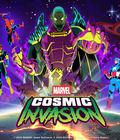Buy Warhammer 40K: Dawn of War III
Warhammer 40K is set in a futuristic fantasy space world that is a dark and unhappy place. This is done in a half-tongue-in-cheek, half-serious method that's also over-the-top. Everything is violent and excessive in ways that are either delightful or outrageous, depending on your taste. If you don't find it exciting to watch fascist Space Marines wielding chainsaw swords while battling enemies, then Warhammer 40K isn't for you. I mention this because the plot in Warhammer 40K: Dawn of War III is largely there for flavor. You're not going to get much out the narrative except an excuse to see the three races — Eldar, Orks and Space Marines — smashing each another.
Dawn of War III is a standard RTS. You focus on gathering resource nodes to build units and construct bases in order to overcome your opponents. It's heavy on the micromanagement, though not as heavy as some games. It feels more old-school than many modern games, including Dawn of War II. That isn't to say it's bare-bones, but it's more focused on giving the entire game a rapid pace. It's very easy to pick up the gameplay basics by hopping into the campaign.
The three available races add some complexity to the proceedings. The Eldar start off weak but can build up to be extremely powerful. Orks, on the other hand, are as disposable as they are crazy. Rather than building up, they focus on swarming the enemy and relying on their superior numbers and ability to gather scrap on the battlefield to overcome their foes. They're the brutes of the game. The Space Marines are a comfortable class that anyone can pick up and play. They focus on brute force, jumping in to stun and shock enemies, and building up to massive melee charges backed by chainsaw swords and drop pods.
Each race is heavily defined by their elite units, which are functionally similar to heroes in Warcraft III and similar games. They're one-of-a-kind units that dominate the battlefield with special abilities, such as disrupting or weakening enemies. The Space Marines' Gabriel Angelos is a brute with a huge hammer who relies on leaping into enemy formations and scattering them while generating shields to protect his allies. He's not a killer on his own, but he can leave enemy units ripe for his allies to clean up. On the other hand, the Orks' Big Mek Wazmakka is an unstoppable war machine who deals insane DPS. You'll find a lot of variation in the elite units and get a chance to play around with most of them, so it's easy to find favorites.
The main campaign shifts between the three different factions, which is both a plus and a negative. It means you never get bored or comfortable with a specific play style, but that means it's harder to get into a comfortable groove. Each of the three races plays differently enough that it can throw you off to shift mindsets. On the other hand, it's a nice tutorial for when things get rough. I can't say it helps you get a feel for the multiplayer, which is significantly different from the campaign, but at least you'll get a feel for each race and understand their mechanics enough to identify a favorite.
The weak multiplayer makes Dawn of War III a tough sell, even for longtime fans. The multiplayer is vaguely reminiscent of a MOBA like League of Legends, and unfortunately, that isn't necessarily a positive. The goal of the multiplayer is to destroy an enemy's central base. To do that, you have to get past specialized turrets that are protected by a shield generator. It gives the multiplayer a more structured feel, so rather than different build orders and base positioning, you have a defined base and can build around it. You'll generally go in the order of generator, turrets and then base, and that gives the game a very rigid play style that can feel forced.
In addition to that, there's an artificial push toward specific game structure with the escalation phase mechanic. Early on in the game, any destroyed unit refunds 25% of the resources, so players have a reason to take heavy risks with expensive units. As the game progresses, you go through several escalation phases. Each time the situation escalates, your structures gain additional HP, and you gain more resources from captured resource nodes. However, you also lose the refund on lost units. By the end, you have more powerful structures but less disposable units. This pushes the game toward heavy early-game skirmishing but more cautious late games, where structures are tougher to destroy and units are more valuable.
This is especially true with your Elites. Different units have different costs, and this is probably the single biggest determination of your play style. Early-game units can be summoned quicker but are less meaningful in battle power. The cheapest elite units are still worth a dozen regular units, but it depends on whether you want to save up points and deploy a heavily armed robot that can singlehandedly win wars. Perhaps you'd rather spend those points early to cripple your opponent before they can deploy their own elites. Add to that the ability to customize elites with doctrines, and it becomes the single most complex part of the multiplayer experience.
"Artificial" is the name of the game in Dawn of War III. All RTS games push toward certain play styles. If you play a Zerg in StarCraft, you're expected to capitalize on their powerful rushing mechanics, but Dawn of War III's multiplayer is heavily structured, which is what draws the MOBA comparisons. The game is clearly intended to have a very specific flow. Short of particularly degenerate strategies being discovered, you're not likely to have a game where you lost because your opponent rushed you before you could get going. The downside is that it provides less freedom and less focus. You're more or less going to play the game in the way the developers had intended.
This leads to the major problem of the multiplayer portion not having a strong identity. It takes a base-heavy micromanagement RTS and slaps it together with a MOBA, and there isn't a strong enough focus on either to really work. The base management aspects feel almost superfluous. Rather than focusing on your build orders and (nonexistent) tech tree, you're churning out units as quickly as possible. At the same time, it lacks the simple focus of a MOBA. It has all the trappings of an RTS in that it expects you to heavily micromanage your characters. The result is a game that lacks the complexity and depth of an RTS but also lacks the pick-up-and-play focus of a MOBA. I can't say that the game won't find its fans, but it's not going to be an easy sell for newcomers or Dawn of War veterans. This is also the only multiplayer mode in Dawn of War III, and it leaves the multiplayer feeling thin and poorly thought-out.
The multiplayer certainly can be fun once you have spent some time with it. It's enjoyable to manage your elites and figure out how to overcome enemy strategies in the moment-to-moment gameplay. It's just tough to say how much lasting value it has. There aren't many maps, and once you have a play style, there isn't a lot that will shift. I had fun with Dawn of War III's multiplayer, but I also could tell that I wouldn't be returning to it once I moved on to something else. The lack of a strong central identity made it difficult to get excited about the idea of going back and customizing my units, rather than returning to a more traditional RTS or a true MOBA.
Dawn of War III is a good-looking game. The characters and animations ooze with style, and the visuals are clear and distinct enough that it's easy to keep track of things in a heavy melee. Some units look too similar for their own good, but that's unfortunately unavoidable with the design limitations, and it's rarely an issue. What really carries the game is the incredibly enthusiastic voice acting. The actors get way into the cheesy excess of the universe and really sell what could otherwise be some dull moments. The Orks are just so happy to be smashing and stabbing that their every line lends tons of flavor of the world.
Dawn of War III is a strong single-player campaign tied to an inconsistent multiplayer. It feels like a more ambitious game than it is able to be. Players who are looking for a single-player adventure will have a lot of fun rampaging through the 15-hour campaign, but those who are in it for the multiplayer may be frustrated by the new and somewhat muddled multiplayer mode. If the multiplayer clicks for you, Dawn of War III will be a delight, but it's a tough sell if you're looking for advancements on prior Dawn of War titles.
Score: 7.5/10
More articles about Warhammer 40,000: Dawn of War III










 Dawn of War III immerses players in the escalating brutality of galactic warfare, where they will lead elite hero units and colossal armies to victory, or oblivion.
Dawn of War III immerses players in the escalating brutality of galactic warfare, where they will lead elite hero units and colossal armies to victory, or oblivion.
























